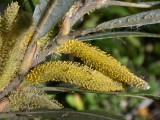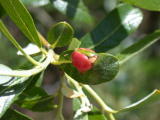| Plant: A low-spreading riparian shrub that
can grow
between 6 and 30 feet tall. Its branches are somewhat
droopy.
The twigs and branches are yellowish-olive to red in color.
Common.
Black Willow is taller, top and bottom of leaves are similar in color and
leaves
are more pointed. |
 |
| Flowers: Are grouped in male and
female catkins
that are
on different plants and appear before the leaves grow. The seeds
bear long and silky hairs. |
  |
| Leaf: The leaves are long and slender, wider near
the middle,
tapering toward the base, 2 1/2 to 4 inches long, 3/4 inch wide, dark
green
above and lighter on the reverse side and many fall off during the
fall. Top and botom view. |
  |
| Leaf Galls caused by the Sawfly (Pontania californica) |
  |
| Stem Gall caused by the Sawfly (Tenthredinidae
Euura) and
Flower Gall caused by the Gall Midge. |
  |
| Flowering period: |
January to March |
| Indian Uses: |
Branches used as arrow shafts and framing for
houses (kishes). Bark was used medicinally to
relieve aches and pains (aspirin like chemical)
and bark fiber used for cordage. |
| Can be found here: |
Big Canyon, Indian Springs Drainage, Interpretive Center |
| Native Plant: Yes |
Halophyte: No |
| Family Name: Willow |
Click on Picture for enlarged version
|
| Similar Species: Black Willow |
Date: 12/26/2009
|